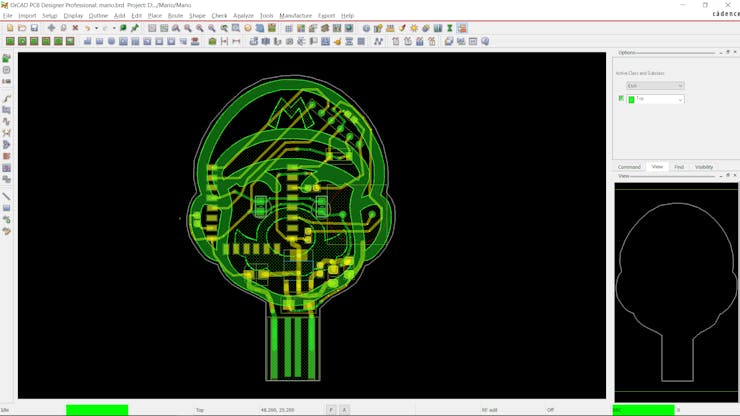It's-a me, Mario
Hey what's up folks, this is my version of Super Mario Theme Player powered by an ESP8266 MCU.
I Made the PCB themed after Mario the Plumber himself, On the TOP Side it's just an Artistic PCB but on the BOTTOM Side I've placed all the important components that drives this board.
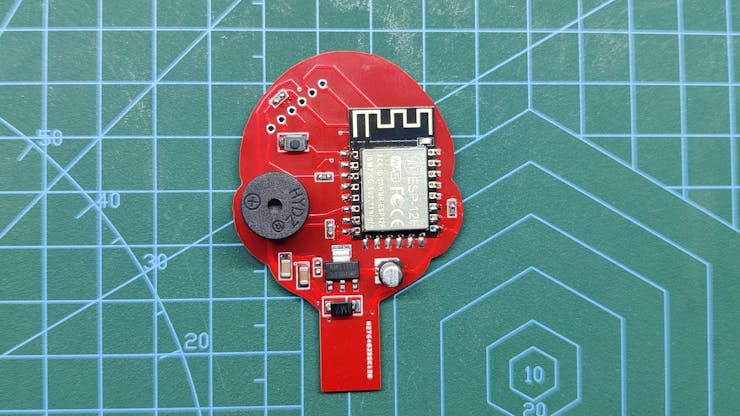

For Powering this setup, I added an ONBOARD USB Pad for making a USB on PCB.
As for the Super Mario Theme song, it's a Note Based Sketch that plays melodies similar to Arduino Note Sketch.
This Board is made in such a way that it can Run any tune that we flash into it. for now, it's playing Super Mario Song but it can play other things as well.
This article is gonna be about its built process so let's get started
Material Required

Following are the componenets I used in this built-
- ESP12F
- Custom PCB
- 10K Resistor
- 10uf Cap
- 1uF Cap
- AMS117 3.3V
- Node MCU for Flashing the ESP12F
- LEDs
- SMD Button
- M7 Diode
- Solder Paste
Why use ESP8266, why not an Arduino board or Attiny85?
I Previously made a similar project in which I used an Attiny85 with a Buzzer to emulate or make R2D2 Sounds. The Sketch that I used was small with less size as it just makes random tones, but the sketch I'm using in this project is completely different.
https://www.pcbway.com/project/shareproject/R2D2_Mini_Edition_1d9aa84a.html
In this project, I'm playing the whole super Mario song and it needs space, a lot of space that Attiny85 doesn't have unfortunately so instead I used an ESP8266.
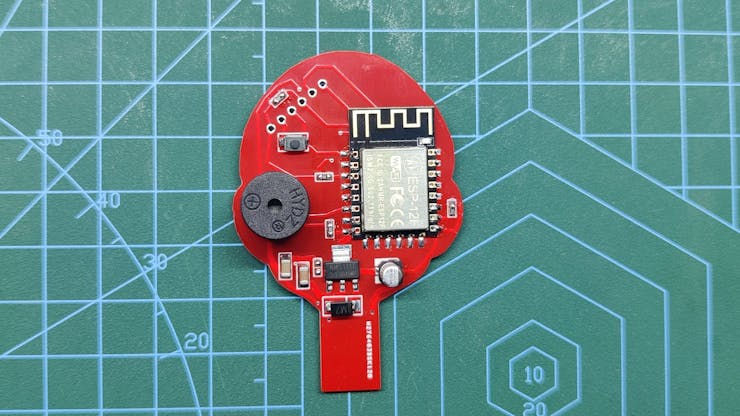
I could use an Arduino Board here but using it would be cheating as I wanted to make a Minimal Setup from scratch, also using Atmega328AU would be an option but its cost is pretty high these days so instead, I use a minimal ESP8266 Setup.
PCB Design + Schematic
Here's the Schematic I prepared.
_5VVNOxh7t1.jpg?auto=compress%2Cformat&w=740&h=555&fit=max)
This is the minimal setup for powering an ESP12F Board, It contains an ESP12F module that is set to run like a normal NodeMCU Board except it doesn't have a USB Flashing Feature as I haven't added any UART IC with it.
I've added Two LEDs and a buzzer with GIPO4 and GPIO12.
After preparing the Schematic, I converted it into a Board file.
I searched for Mario's Black and white image which I later used to prepare the board outline and other facial features like his iconic mustache and eyebrows.
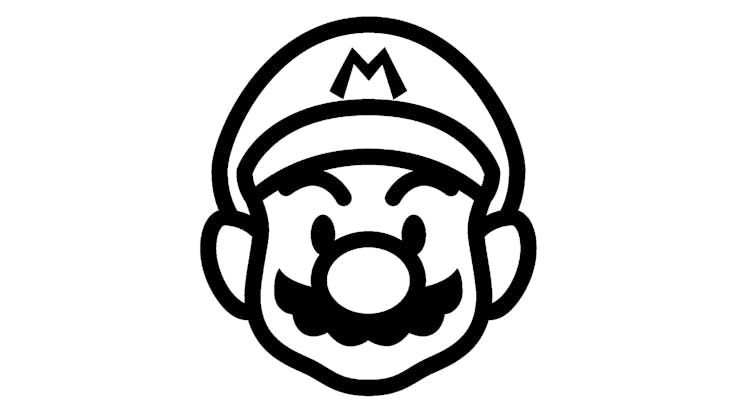
PCBWAY Review!


After completing the design, I uploaded the Gerber data on PCBWAY's quote page, selected the solder mask color which was RED, and placed the order.
I choose RED Soldermask as Mario is RED and Silver would look cool.
After placing the order, I received the PCBs in a week and the PCB quality was pretty great.
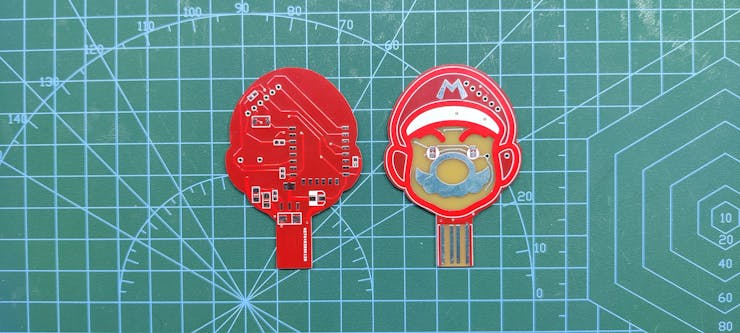
I left a few Soldermask Openings in the TOP Layer and the shape of this PCB was also not exactly easy to produce but PCBWAY did an Awesome job of making it with no problem whatsoever.
Really loved the end result.
You can checkout PCBWAY from here- www.pcbway.com
PCB ASSEMBLY
After unboxing the PCBs, I started the assembly process which had the following steps.
- Solder Paste Dispensing
- Pick & Place Process
- Hotplate Reflow
- Adding LEDs
- Adding Buzzer
Solder paste

Now the first step is to add solder paste to each component pad one by one.
To Apply solder paste, I'm using a Solderpaste Dispensing Needle with a Wide syringe, and the solder paste I'm using is a regular solder paste consisting of 63% Tin and37% Lead.
Pick & Place Process

After applying Solderpaste we move on to the next step which is to add components to their assigned location.
HOTPLATE REFLOW


After the "Pick & Place Process", I carefully lifted the whole circuit board and place it on my DIY SMT Hotplate.
the hotplate heats the PCB from below up to the solder paste melting temp, as soon as the PCB reaches that temp, solder paste melts and all the components get soldered to their pads, we lift the PCB and then place it on a cooler surface for a little bit, to cool down the heat of PCB.
Adding LEDs



After the Reflow process, I added two LEDs on the TOP Side of the Board.
Adding Buzzer


At Last, I added a Buzzer in its assigned place.
Flashing ESP8266 with NodeMCU


we start first by shorting the Enable pin and GND, this will turn off the esp12F of the Nodemcu and now we can connect an external ESP12F setup with the Nodemcu according to the given schematic.
I designed the Mario PCB in such a way that I can connect the NODEMCU PROGRAMMER PCB with this setup by plugging the Mario Board onto the Programmer Board's CON6 Pin which consists of 3V, GND, RST, GPIO0, TX, and RX Pins.
It's a clever method to use as because of this external programmer, we don't need to add FTDI Chips on ESP12F setup and we can make smaller PCBs and for programming them we just breakout 6 important pins and connect our external programmer with it.

For Programming the ESP12F board, we need to connect the NodeMCU with our ESP12F Setup in this way-
- 3v to 3v
- GND to GND
- RST to RST
- GPIO0 to GPIO0 //D3 is GPIO0 on Nodemcu
- TX to TX
- RX to RX
Also, do not forget to add a Jumper wire between ENA and GND Pin on Nodemcu. this will turn off the ESP12F of the Nodemcu and our external ESP12F will get connected with the Nodemcu's CP2102 chip.
Blink Sketch to check LEDs


As for the test sketch, I'm using Blink sketch to test the leds and the ESP12F Setup. LEDs are connected on GIPO4.
Connect the Nodemcu programmer with the ESP12F Board
open Arduino ide, plug the USB on Nodemcu
then go to the Tools menu and select the Nodemcu board that you are using
select the right port and hit upload
Do check out this video of mine for a brief version-
Main Code
Here's the main code that I'm using.
/*
Super Mario Bros - Overworld theme
Connect a piezo buzzer or speaker to pin 11 or select a new pin.
More songs available at https://github.com/robsoncouto/arduino-songs
Robson Couto, 2019
*/
#define NOTE_B0 31
#define NOTE_C1 33
#define NOTE_CS1 35
#define NOTE_D1 37
#define NOTE_DS1 39
#define NOTE_E1 41
#define NOTE_F1 44
#define NOTE_FS1 46
#define NOTE_G1 49
#define NOTE_GS1 52
#define NOTE_A1 55
#define NOTE_AS1 58
#define NOTE_B1 62
#define NOTE_C2 65
#define NOTE_CS2 69
#define NOTE_D2 73
#define NOTE_DS2 78
#define NOTE_E2 82
#define NOTE_F2 87
#define NOTE_FS2 93
#define NOTE_G2 98
#define NOTE_GS2 104
#define NOTE_A2 110
#define NOTE_AS2 117
#define NOTE_B2 123
#define NOTE_C3 131
#define NOTE_CS3 139
#define NOTE_D3 147
#define NOTE_DS3 156
#define NOTE_E3 165
#define NOTE_F3 175
#define NOTE_FS3 185
#define NOTE_G3 196
#define NOTE_GS3 208
#define NOTE_A3 220
#define NOTE_AS3 233
#define NOTE_B3 247
#define NOTE_C4 262
#define NOTE_CS4 277
#define NOTE_D4 294
#define NOTE_DS4 311
#define NOTE_E4 330
#define NOTE_F4 349
#define NOTE_FS4 370
#define NOTE_G4 392
#define NOTE_GS4 415
#define NOTE_A4 440
#define NOTE_AS4 466
#define NOTE_B4 494
#define NOTE_C5 523
#define NOTE_CS5 554
#define NOTE_D5 587
#define NOTE_DS5 622
#define NOTE_E5 659
#define NOTE_F5 698
#define NOTE_FS5 740
#define NOTE_G5 784
#define NOTE_GS5 831
#define NOTE_A5 880
#define NOTE_AS5 932
#define NOTE_B5 988
#define NOTE_C6 1047
#define NOTE_CS6 1109
#define NOTE_D6 1175
#define NOTE_DS6 1245
#define NOTE_E6 1319
#define NOTE_F6 1397
#define NOTE_FS6 1480
#define NOTE_G6 1568
#define NOTE_GS6 1661
#define NOTE_A6 1760
#define NOTE_AS6 1865
#define NOTE_B6 1976
#define NOTE_C7 2093
#define NOTE_CS7 2217
#define NOTE_D7 2349
#define NOTE_DS7 2489
#define NOTE_E7 2637
#define NOTE_F7 2794
#define NOTE_FS7 2960
#define NOTE_G7 3136
#define NOTE_GS7 3322
#define NOTE_A7 3520
#define NOTE_AS7 3729
#define NOTE_B7 3951
#define NOTE_C8 4186
#define NOTE_CS8 4435
#define NOTE_D8 4699
#define NOTE_DS8 4978
#define REST 0
// change this to make the song slower or faster
int tempo = 200;
// change this to whichever pin you want to use
int buzzer = 12;
// notes of the moledy followed by the duration.
// a 4 means a quarter note, 8 an eighteenth , 16 sixteenth, so on
// !!negative numbers are used to represent dotted notes,
// so -4 means a dotted quarter note, that is, a quarter plus an eighteenth!!
int melody[] = {
// Super Mario Bros theme
// Score available at https://musescore.com/user/2123/scores/2145
// Theme by Koji Kondo
NOTE_E5,8, NOTE_E5,8, REST,8, NOTE_E5,8, REST,8, NOTE_C5,8, NOTE_E5,8, //1
NOTE_G5,4, REST,4, NOTE_G4,8, REST,4,
NOTE_C5,-4, NOTE_G4,8, REST,4, NOTE_E4,-4, // 3
NOTE_A4,4, NOTE_B4,4, NOTE_AS4,8, NOTE_A4,4,
NOTE_G4,-8, NOTE_E5,-8, NOTE_G5,-8, NOTE_A5,4, NOTE_F5,8, NOTE_G5,8,
REST,8, NOTE_E5,4,NOTE_C5,8, NOTE_D5,8, NOTE_B4,-4,
NOTE_C5,-4, NOTE_G4,8, REST,4, NOTE_E4,-4, // repeats from 3
NOTE_A4,4, NOTE_B4,4, NOTE_AS4,8, NOTE_A4,4,
NOTE_G4,-8, NOTE_E5,-8, NOTE_G5,-8, NOTE_A5,4, NOTE_F5,8, NOTE_G5,8,
REST,8, NOTE_E5,4,NOTE_C5,8, NOTE_D5,8, NOTE_B4,-4,
REST,4, NOTE_G5,8, NOTE_FS5,8, NOTE_F5,8, NOTE_DS5,4, NOTE_E5,8,//7
REST,8, NOTE_GS4,8, NOTE_A4,8, NOTE_C4,8, REST,8, NOTE_A4,8, NOTE_C5,8, NOTE_D5,8,
REST,4, NOTE_DS5,4, REST,8, NOTE_D5,-4,
NOTE_C5,2, REST,2,
REST,4, NOTE_G5,8, NOTE_FS5,8, NOTE_F5,8, NOTE_DS5,4, NOTE_E5,8,//repeats from 7
REST,8, NOTE_GS4,8, NOTE_A4,8, NOTE_C4,8, REST,8, NOTE_A4,8, NOTE_C5,8, NOTE_D5,8,
REST,4, NOTE_DS5,4, REST,8, NOTE_D5,-4,
NOTE_C5,2, REST,2,
NOTE_C5,8, NOTE_C5,4, NOTE_C5,8, REST,8, NOTE_C5,8, NOTE_D5,4,//11
NOTE_E5,8, NOTE_C5,4, NOTE_A4,8, NOTE_G4,2,
NOTE_C5,8, NOTE_C5,4, NOTE_C5,8, REST,8, NOTE_C5,8, NOTE_D5,8, NOTE_E5,8,//13
REST,1,
NOTE_C5,8, NOTE_C5,4, NOTE_C5,8, REST,8, NOTE_C5,8, NOTE_D5,4,
NOTE_E5,8, NOTE_C5,4, NOTE_A4,8, NOTE_G4,2,
NOTE_E5,8, NOTE_E5,8, REST,8, NOTE_E5,8, REST,8, NOTE_C5,8, NOTE_E5,4,
NOTE_G5,4, REST,4, NOTE_G4,4, REST,4,
NOTE_C5,-4, NOTE_G4,8, REST,4, NOTE_E4,-4, // 19
NOTE_A4,4, NOTE_B4,4, NOTE_AS4,8, NOTE_A4,4,
NOTE_G4,-8, NOTE_E5,-8, NOTE_G5,-8, NOTE_A5,4, NOTE_F5,8, NOTE_G5,8,
REST,8, NOTE_E5,4, NOTE_C5,8, NOTE_D5,8, NOTE_B4,-4,
NOTE_C5,-4, NOTE_G4,8, REST,4, NOTE_E4,-4, // repeats from 19
NOTE_A4,4, NOTE_B4,4, NOTE_AS4,8, NOTE_A4,4,
NOTE_G4,-8, NOTE_E5,-8, NOTE_G5,-8, NOTE_A5,4, NOTE_F5,8, NOTE_G5,8,
REST,8, NOTE_E5,4, NOTE_C5,8, NOTE_D5,8, NOTE_B4,-4,
NOTE_E5,8, NOTE_C5,4, NOTE_G4,8, REST,4, NOTE_GS4,4,//23
NOTE_A4,8, NOTE_F5,4, NOTE_F5,8, NOTE_A4,2,
NOTE_D5,-8, NOTE_A5,-8, NOTE_A5,-8, NOTE_A5,-8, NOTE_G5,-8, NOTE_F5,-8,
NOTE_E5,8, NOTE_C5,4, NOTE_A4,8, NOTE_G4,2, //26
NOTE_E5,8, NOTE_C5,4, NOTE_G4,8, REST,4, NOTE_GS4,4,
NOTE_A4,8, NOTE_F5,4, NOTE_F5,8, NOTE_A4,2,
NOTE_B4,8, NOTE_F5,4, NOTE_F5,8, NOTE_F5,-8, NOTE_E5,-8, NOTE_D5,-8,
NOTE_C5,8, NOTE_E4,4, NOTE_E4,8, NOTE_C4,2,
NOTE_E5,8, NOTE_C5,4, NOTE_G4,8, REST,4, NOTE_GS4,4,//repeats from 23
NOTE_A4,8, NOTE_F5,4, NOTE_F5,8, NOTE_A4,2,
NOTE_D5,-8, NOTE_A5,-8, NOTE_A5,-8, NOTE_A5,-8, NOTE_G5,-8, NOTE_F5,-8,
NOTE_E5,8, NOTE_C5,4, NOTE_A4,8, NOTE_G4,2, //26
NOTE_E5,8, NOTE_C5,4, NOTE_G4,8, REST,4, NOTE_GS4,4,
NOTE_A4,8, NOTE_F5,4, NOTE_F5,8, NOTE_A4,2,
NOTE_B4,8, NOTE_F5,4, NOTE_F5,8, NOTE_F5,-8, NOTE_E5,-8, NOTE_D5,-8,
NOTE_C5,8, NOTE_E4,4, NOTE_E4,8, NOTE_C4,2,
NOTE_C5,8, NOTE_C5,4, NOTE_C5,8, REST,8, NOTE_C5,8, NOTE_D5,8, NOTE_E5,8,
REST,1,
NOTE_C5,8, NOTE_C5,4, NOTE_C5,8, REST,8, NOTE_C5,8, NOTE_D5,4, //33
NOTE_E5,8, NOTE_C5,4, NOTE_A4,8, NOTE_G4,2,
NOTE_E5,8, NOTE_E5,8, REST,8, NOTE_E5,8, REST,8, NOTE_C5,8, NOTE_E5,4,
NOTE_G5,4, REST,4, NOTE_G4,4, REST,4,
NOTE_E5,8, NOTE_C5,4, NOTE_G4,8, REST,4, NOTE_GS4,4,
NOTE_A4,8, NOTE_F5,4, NOTE_F5,8, NOTE_A4,2,
NOTE_D5,-8, NOTE_A5,-8, NOTE_A5,-8, NOTE_A5,-8, NOTE_G5,-8, NOTE_F5,-8,
NOTE_E5,8, NOTE_C5,4, NOTE_A4,8, NOTE_G4,2, //40
NOTE_E5,8, NOTE_C5,4, NOTE_G4,8, REST,4, NOTE_GS4,4,
NOTE_A4,8, NOTE_F5,4, NOTE_F5,8, NOTE_A4,2,
NOTE_B4,8, NOTE_F5,4, NOTE_F5,8, NOTE_F5,-8, NOTE_E5,-8, NOTE_D5,-8,
NOTE_C5,8, NOTE_E4,4, NOTE_E4,8, NOTE_C4,2,
//game over sound
NOTE_C5,-4, NOTE_G4,-4, NOTE_E4,4, //45
NOTE_A4,-8, NOTE_B4,-8, NOTE_A4,-8, NOTE_GS4,-8, NOTE_AS4,-8, NOTE_GS4,-8,
NOTE_G4,8, NOTE_D4,8, NOTE_E4,-2,
};
// sizeof gives the number of bytes, each int value is composed of two bytes (16 bits)
// there are two values per note (pitch and duration), so for each note there are four bytes
int notes = sizeof(melody) / sizeof(melody[0]) / 2;
// this calculates the duration of a whole note in ms
int wholenote = (60000 * 4) / tempo;
int divider = 0, noteDuration = 0;
void setup() {
// iterate over the notes of the melody.
// Remember, the array is twice the number of notes (notes + durations)
for (int thisNote = 0; thisNote < notes * 2; thisNote = thisNote + 2) {
// calculates the duration of each note
divider = melody[thisNote + 1];
if (divider > 0) {
// regular note, just proceed
noteDuration = (wholenote) / divider;
} else if (divider < 0) {
// dotted notes are represented with negative durations!!
noteDuration = (wholenote) / abs(divider);
noteDuration *= 1.5; // increases the duration in half for dotted notes
}
// we only play the note for 90% of the duration, leaving 10% as a pause
tone(buzzer, melody[thisNote], noteDuration * 0.9);
// Wait for the specief duration before playing the next note.
delay(noteDuration);
// stop the waveform generation before the next note.
noTone(buzzer);
}
}
void loop() {
// no need to repeat the melody.
}
I used the same uploading method for uploading this sketch into ESP8266.
Result
Here's the result, check out the video for the super Mario theme song!
Thanks for reading this article, if you need any help regarding this project, DM me or comment.
Special thanks to PCBWAY for supporting this project, you guys can check them out if you need great PCB Service for less cost.
Peace out.
/*
Super Mario Bros - Overworld theme
Connect a piezo buzzer or speaker to pin 11 or select a new pin.
More songs available at https://github.com/robsoncouto/arduino-songs
Robson Couto, 2019
*/
#define NOTE_B0 31
#define NOTE_C1 33
#define NOTE_CS1 35
#define NOTE_D1 37
#define NOTE_DS1 39
#define NOTE_E1 41
#define NOTE_F1 44
#define NOTE_FS1 46
#define NOTE_G1 49
#define NOTE_GS1 52
#define NOTE_A1 55
#define NOTE_AS1 58
#define NOTE_B1 62
#define NOTE_C2 65
#define NOTE_CS2 69
#define NOTE_D2 73
#define NOTE_DS2 78
#define NOTE_E2 82
#define NOTE_F2 87
#define NOTE_FS2 93
#define NOTE_G2 98
#define NOTE_GS2 104
#define NOTE_A2 110
#define NOTE_AS2 117
#define NOTE_B2 123
#define NOTE_C3 131
#define NOTE_CS3 139
#define NOTE_D3 147
#define NOTE_DS3 156
#define NOTE_E3 165
#define NOTE_F3 175
#define NOTE_FS3 185
#define NOTE_G3 196
#define NOTE_GS3 208
#define NOTE_A3 220
#define NOTE_AS3 233
#define NOTE_B3 247
#define NOTE_C4 262
#define NOTE_CS4 277
#define NOTE_D4 294
#define NOTE_DS4 311
#define NOTE_E4 330
#define NOTE_F4 349
#define NOTE_FS4 370
#define NOTE_G4 392
#define NOTE_GS4 415
#define NOTE_A4 440
#define NOTE_AS4 466
#define NOTE_B4 494
#define NOTE_C5 523
#define NOTE_CS5 554
#define NOTE_D5 587
#define NOTE_DS5 622
#define NOTE_E5 659
#define NOTE_F5 698
#define NOTE_FS5 740
#define NOTE_G5 784
#define NOTE_GS5 831
#define NOTE_A5 880
#define NOTE_AS5 932
#define NOTE_B5 988
#define NOTE_C6 1047
#define NOTE_CS6 1109
#define NOTE_D6 1175
#define NOTE_DS6 1245
#define NOTE_E6 1319
#define NOTE_F6 1397
#define NOTE_FS6 1480
#define NOTE_G6 1568
#define NOTE_GS6 1661
#define NOTE_A6 1760
#define NOTE_AS6 1865
#define NOTE_B6 1976
#define NOTE_C7 2093
#define NOTE_CS7 2217
#define NOTE_D7 2349
#define NOTE_DS7 2489
#define NOTE_E7 2637
#define NOTE_F7 2794
#define NOTE_FS7 2960
#define NOTE_G7 3136
#define NOTE_GS7 3322
#define NOTE_A7 3520
#define NOTE_AS7 3729
#define NOTE_B7 3951
#define NOTE_C8 4186
#define NOTE_CS8 4435
#define NOTE_D8 4699
#define NOTE_DS8 4978
#define REST 0
// change this to make the song slower or faster
int tempo = 200;
// change this to whichever pin you want to use
int buzzer = 12;
// notes of the moledy followed by the duration.
// a 4 means a quarter note, 8 an eighteenth , 16 sixteenth, so on
// !!negative numbers are used to represent dotted notes,
// so -4 means a dotted quarter note, that is, a quarter plus an eighteenth!!
int melody[] = {
// Super Mario Bros theme
// Score available at https://musescore.com/user/2123/scores/2145
// Theme by Koji Kondo
NOTE_E5,8, NOTE_E5,8, REST,8, NOTE_E5,8, REST,8, NOTE_C5,8, NOTE_E5,8, //1
NOTE_G5,4, REST,4, NOTE_G4,8, REST,4,
NOTE_C5,-4, NOTE_G4,8, REST,4, NOTE_E4,-4, // 3
NOTE_A4,4, NOTE_B4,4, NOTE_AS4,8, NOTE_A4,4,
NOTE_G4,-8, NOTE_E5,-8, NOTE_G5,-8, NOTE_A5,4, NOTE_F5,8, NOTE_G5,8,
REST,8, NOTE_E5,4,NOTE_C5,8, NOTE_D5,8, NOTE_B4,-4,
NOTE_C5,-4, NOTE_G4,8, REST,4, NOTE_E4,-4, // repeats from 3
NOTE_A4,4, NOTE_B4,4, NOTE_AS4,8, NOTE_A4,4,
NOTE_G4,-8, NOTE_E5,-8, NOTE_G5,-8, NOTE_A5,4, NOTE_F5,8, NOTE_G5,8,
REST,8, NOTE_E5,4,NOTE_C5,8, NOTE_D5,8, NOTE_B4,-4,
REST,4, NOTE_G5,8, NOTE_FS5,8, NOTE_F5,8, NOTE_DS5,4, NOTE_E5,8,//7
REST,8, NOTE_GS4,8, NOTE_A4,8, NOTE_C4,8, REST,8, NOTE_A4,8, NOTE_C5,8, NOTE_D5,8,
REST,4, NOTE_DS5,4, REST,8, NOTE_D5,-4,
NOTE_C5,2, REST,2,
REST,4, NOTE_G5,8, NOTE_FS5,8, NOTE_F5,8, NOTE_DS5,4, NOTE_E5,8,//repeats from 7
REST,8, NOTE_GS4,8, NOTE_A4,8, NOTE_C4,8, REST,8, NOTE_A4,8, NOTE_C5,8, NOTE_D5,8,
REST,4, NOTE_DS5,4, REST,8, NOTE_D5,-4,
NOTE_C5,2, REST,2,
NOTE_C5,8, NOTE_C5,4, NOTE_C5,8, REST,8, NOTE_C5,8, NOTE_D5,4,//11
NOTE_E5,8, NOTE_C5,4, NOTE_A4,8, NOTE_G4,2,
NOTE_C5,8, NOTE_C5,4, NOTE_C5,8, REST,8, NOTE_C5,8, NOTE_D5,8, NOTE_E5,8,//13
REST,1,
NOTE_C5,8, NOTE_C5,4, NOTE_C5,8, REST,8, NOTE_C5,8, NOTE_D5,4,
NOTE_E5,8, NOTE_C5,4, NOTE_A4,8, NOTE_G4,2,
NOTE_E5,8, NOTE_E5,8, REST,8, NOTE_E5,8, REST,8, NOTE_C5,8, NOTE_E5,4,
NOTE_G5,4, REST,4, NOTE_G4,4, REST,4,
NOTE_C5,-4, NOTE_G4,8, REST,4, NOTE_E4,-4, // 19
NOTE_A4,4, NOTE_B4,4, NOTE_AS4,8, NOTE_A4,4,
NOTE_G4,-8, NOTE_E5,-8, NOTE_G5,-8, NOTE_A5,4, NOTE_F5,8, NOTE_G5,8,
REST,8, NOTE_E5,4, NOTE_C5,8, NOTE_D5,8, NOTE_B4,-4,
NOTE_C5,-4, NOTE_G4,8, REST,4, NOTE_E4,-4, // repeats from 19
NOTE_A4,4, NOTE_B4,4, NOTE_AS4,8, NOTE_A4,4,
NOTE_G4,-8, NOTE_E5,-8, NOTE_G5,-8, NOTE_A5,4, NOTE_F5,8, NOTE_G5,8,
REST,8, NOTE_E5,4, NOTE_C5,8, NOTE_D5,8, NOTE_B4,-4,
NOTE_E5,8, NOTE_C5,4, NOTE_G4,8, REST,4, NOTE_GS4,4,//23
NOTE_A4,8, NOTE_F5,4, NOTE_F5,8, NOTE_A4,2,
NOTE_D5,-8, NOTE_A5,-8, NOTE_A5,-8, NOTE_A5,-8, NOTE_G5,-8, NOTE_F5,-8,
NOTE_E5,8, NOTE_C5,4, NOTE_A4,8, NOTE_G4,2, //26
NOTE_E5,8, NOTE_C5,4, NOTE_G4,8, REST,4, NOTE_GS4,4,
NOTE_A4,8, NOTE_F5,4, NOTE_F5,8, NOTE_A4,2,
NOTE_B4,8, NOTE_F5,4, NOTE_F5,8, NOTE_F5,-8, NOTE_E5,-8, NOTE_D5,-8,
NOTE_C5,8, NOTE_E4,4, NOTE_E4,8, NOTE_C4,2,
NOTE_E5,8, NOTE_C5,4, NOTE_G4,8, REST,4, NOTE_GS4,4,//repeats from 23
NOTE_A4,8, NOTE_F5,4, NOTE_F5,8, NOTE_A4,2,
NOTE_D5,-8, NOTE_A5,-8, NOTE_A5,-8, NOTE_A5,-8, NOTE_G5,-8, NOTE_F5,-8,
NOTE_E5,8, NOTE_C5,4, NOTE_A4,8, NOTE_G4,2, //26
NOTE_E5,8, NOTE_C5,4, NOTE_G4,8, REST,4, NOTE_GS4,4,
NOTE_A4,8, NOTE_F5,4, NOTE_F5,8, NOTE_A4,2,
NOTE_B4,8, NOTE_F5,4, NOTE_F5,8, NOTE_F5,-8, NOTE_E5,-8, NOTE_D5,-8,
NOTE_C5,8, NOTE_E4,4, NOTE_E4,8, NOTE_C4,2,
NOTE_C5,8, NOTE_C5,4, NOTE_C5,8, REST,8, NOTE_C5,8, NOTE_D5,8, NOTE_E5,8,
REST,1,
NOTE_C5,8, NOTE_C5,4, NOTE_C5,8, REST,8, NOTE_C5,8, NOTE_D5,4, //33
NOTE_E5,8, NOTE_C5,4, NOTE_A4,8, NOTE_G4,2,
NOTE_E5,8, NOTE_E5,8, REST,8, NOTE_E5,8, REST,8, NOTE_C5,8, NOTE_E5,4,
NOTE_G5,4, REST,4, NOTE_G4,4, REST,4,
NOTE_E5,8, NOTE_C5,4, NOTE_G4,8, REST,4, NOTE_GS4,4,
NOTE_A4,8, NOTE_F5,4, NOTE_F5,8, NOTE_A4,2,
NOTE_D5,-8, NOTE_A5,-8, NOTE_A5,-8, NOTE_A5,-8, NOTE_G5,-8, NOTE_F5,-8,
NOTE_E5,8, NOTE_C5,4, NOTE_A4,8, NOTE_G4,2, //40
NOTE_E5,8, NOTE_C5,4, NOTE_G4,8, REST,4, NOTE_GS4,4,
NOTE_A4,8, NOTE_F5,4, NOTE_F5,8, NOTE_A4,2,
NOTE_B4,8, NOTE_F5,4, NOTE_F5,8, NOTE_F5,-8, NOTE_E5,-8, NOTE_D5,-8,
NOTE_C5,8, NOTE_E4,4, NOTE_E4,8, NOTE_C4,2,
//game over sound
NOTE_C5,-4, NOTE_G4,-4, NOTE_E4,4, //45
NOTE_A4,-8, NOTE_B4,-8, NOTE_A4,-8, NOTE_GS4,-8, NOTE_AS4,-8, NOTE_GS4,-8,
NOTE_G4,8, NOTE_D4,8, NOTE_E4,-2,
};
// sizeof gives the number of bytes, each int value is composed of two bytes (16 bits)
// there are two values per note (pitch and duration), so for each note there are four bytes
int notes = sizeof(melody) / sizeof(melody[0]) / 2;
// this calculates the duration of a whole note in ms
int wholenote = (60000 * 4) / tempo;
int divider = 0, noteDuration = 0;
void setup() {
// iterate over the notes of the melody.
// Remember, the array is twice the number of notes (notes + durations)
for (int thisNote = 0; thisNote < notes * 2; thisNote = thisNote + 2) {
// calculates the duration of each note
divider = melody[thisNote + 1];
if (divider > 0) {
// regular note, just proceed
noteDuration = (wholenote) / divider;
} else if (divider < 0) {
// dotted notes are represented with negative durations!!
noteDuration = (wholenote) / abs(divider);
noteDuration *= 1.5; // increases the duration in half for dotted notes
}
// we only play the note for 90% of the duration, leaving 10% as a pause
tone(buzzer, melody[thisNote], noteDuration * 0.9);
// Wait for the specief duration before playing the next note.
delay(noteDuration);
// stop the waveform generation before the next note.
noTone(buzzer);
}
}
void loop() {
// no need to repeat the melody.
}

It's-a me, Mario
*PCBWay community is a sharing platform. We are not responsible for any design issues and parameter issues (board thickness, surface finish, etc.) you choose.
- Comments(0)
- Likes(2)
-
 IObrizio Fabrizio
May 31,2022
IObrizio Fabrizio
May 31,2022
-
 dr selim
May 30,2022
dr selim
May 30,2022
- 0 USER VOTES
- YOUR VOTE 0.00 0.00
- 1
- 2
- 3
- 4
- 5
- 6
- 7
- 8
- 9
- 10
- 1
- 2
- 3
- 4
- 5
- 6
- 7
- 8
- 9
- 10
- 1
- 2
- 3
- 4
- 5
- 6
- 7
- 8
- 9
- 10
- 1
- 2
- 3
- 4
- 5
- 6
- 7
- 8
- 9
- 10
 More by Arnov Arnov sharma
More by Arnov Arnov sharma
-
 Pocket SNES
Greetings everyone, and welcome back! Today, I’ve got something fun and tiny to share—the Pocket SNE...
Pocket SNES
Greetings everyone, and welcome back! Today, I’ve got something fun and tiny to share—the Pocket SNE...
-
 Batocera Arcade Box
Greetings everyone and welcome back, Here's something. Fun and nostalgic. Right now, we are using ou...
Batocera Arcade Box
Greetings everyone and welcome back, Here's something. Fun and nostalgic. Right now, we are using ou...
-
 64x32 Matrix Panel Setup with PICO 2
Greetings everyone and welcome back.So here's something fun and useful: a Raspberry Pi Pico 2-powere...
64x32 Matrix Panel Setup with PICO 2
Greetings everyone and welcome back.So here's something fun and useful: a Raspberry Pi Pico 2-powere...
-
 Portable Air Quality Meter
Hello everyone, and welcome back! Today, I have something incredibly useful for you—a Portable Air Q...
Portable Air Quality Meter
Hello everyone, and welcome back! Today, I have something incredibly useful for you—a Portable Air Q...
-
 WALKPi PCB Version
Greetings everyone and welcome back, This is the WalkPi, a homebrew audio player that plays music fr...
WALKPi PCB Version
Greetings everyone and welcome back, This is the WalkPi, a homebrew audio player that plays music fr...
-
 Delete Button XL
Greetings everyone and welcome back, and here's something fun and useful.In essence, the Delete Butt...
Delete Button XL
Greetings everyone and welcome back, and here's something fun and useful.In essence, the Delete Butt...
-
 Arduino Retro Game Controller
Greetings everyone and welcome back. Here's something fun.The Arduino Retro Game Controller was buil...
Arduino Retro Game Controller
Greetings everyone and welcome back. Here's something fun.The Arduino Retro Game Controller was buil...
-
 Super Power Buck Converter
Greetings everyone and welcome back!Here's something powerful, The SUPER POWER BUCK CONVERTER BOARD ...
Super Power Buck Converter
Greetings everyone and welcome back!Here's something powerful, The SUPER POWER BUCK CONVERTER BOARD ...
-
 Pocket Temp Meter
Greetings and welcome back.So here's something portable and useful: the Pocket TEMP Meter project.As...
Pocket Temp Meter
Greetings and welcome back.So here's something portable and useful: the Pocket TEMP Meter project.As...
-
 Pico Powered DC Fan Driver
Hello everyone and welcome back.So here's something cool: a 5V to 12V DC motor driver based around a...
Pico Powered DC Fan Driver
Hello everyone and welcome back.So here's something cool: a 5V to 12V DC motor driver based around a...
-
 Mini Solar Light Project with a Twist
Greetings.This is the Cube Light, a Small and compact cube-shaped emergency solar light that boasts ...
Mini Solar Light Project with a Twist
Greetings.This is the Cube Light, a Small and compact cube-shaped emergency solar light that boasts ...
-
 PALPi V5 Handheld Retro Game Console
Hey, Guys what's up?So this is PALPi which is a Raspberry Pi Zero W Based Handheld Retro Game Consol...
PALPi V5 Handheld Retro Game Console
Hey, Guys what's up?So this is PALPi which is a Raspberry Pi Zero W Based Handheld Retro Game Consol...
-
 DIY Thermometer with TTGO T Display and DS18B20
Greetings.So this is the DIY Thermometer made entirely from scratch using a TTGO T display board and...
DIY Thermometer with TTGO T Display and DS18B20
Greetings.So this is the DIY Thermometer made entirely from scratch using a TTGO T display board and...
-
 Motion Trigger Circuit with and without Microcontroller
GreetingsHere's a tutorial on how to use an HC-SR505 PIR Module with and without a microcontroller t...
Motion Trigger Circuit with and without Microcontroller
GreetingsHere's a tutorial on how to use an HC-SR505 PIR Module with and without a microcontroller t...
-
 Motor Driver Board Atmega328PU and HC01
Hey, what's up folks here's something super cool and useful if you're making a basic Robot Setup, A ...
Motor Driver Board Atmega328PU and HC01
Hey, what's up folks here's something super cool and useful if you're making a basic Robot Setup, A ...
-
 Power Block
Hey Everyone what's up!So this is Power block, a DIY UPS that can be used to power a bunch of 5V Ope...
Power Block
Hey Everyone what's up!So this is Power block, a DIY UPS that can be used to power a bunch of 5V Ope...
-
 Goku PCB Badge V2
Hey everyone what's up!So here's something SUPER cool, A PCB Board themed after Goku from Dragon Bal...
Goku PCB Badge V2
Hey everyone what's up!So here's something SUPER cool, A PCB Board themed after Goku from Dragon Bal...
-
 RGB Mixinator V2
Hey Everyone how you doin!So here's a fun little project that utilizes an Arduino Nano, THE MIXINATO...
RGB Mixinator V2
Hey Everyone how you doin!So here's a fun little project that utilizes an Arduino Nano, THE MIXINATO...
-
-
mammoth-3D SLM Voron Toolhead – Manual Drill & Tap Edition
231 0 0 -
-
AEL-2011 Power Supply Module
756 0 2 -
AEL-2011 50W Power Amplifier
630 0 2 -
-
-
Custom Mechanical Keyboard
824 0 0 -
Tester for Touch Screen Digitizer without using microcontroller
448 2 2 -
Audio reactive glow LED wristband/bracelet with NFC / RFID-Tags
402 0 1 -
-












